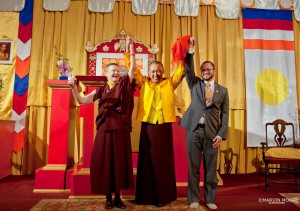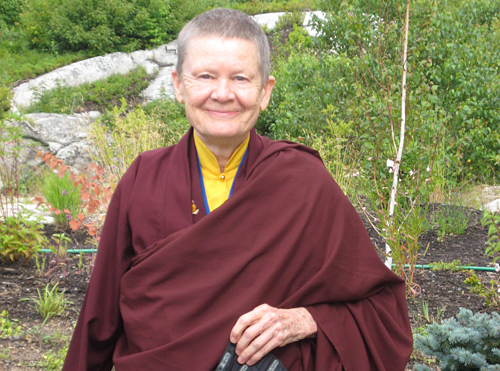Friday
Featured StoriesStepping into Groundlessness: Interview with Pema Chodron
Pema Chodron is a spiritual icon and one of the most influential and recognizable Buddhists in the world. A bestselling author and prolific teacher, she has touched the lives of countless individuals and in turn is fervently adored by many people, and not just Buddhists.
But the Pema I am drawn to — and I imagine most Pema Chodron fans out there feel the same way — is not just a celebrity, but a real-world Buddhist nun who works with her mind and doesn’t sugarcoat the truth. Genuine, playful, kind, and humble, the secret to Pema’s success seems to be that she has no secret. She is able to help people work with fear and confusion because she has worked with her own fear and confusion. There’s no wizard behind the curtain. There’s just Pema, and she’s practicing just as we can.
This summer, before the start of the Being Brave: Transforming Our World program in Halifax, Nova Scotia, I was able to sit and talk with Pema about a wide range of issues, from her teachers, spiritual materialism, the current state of monasticism, to the harsh realities of the world we live in.
– Monty McKeever
Please tell me about this Being Brave: Transforming Our World program you’re about to teach with Sakyong Mipham Rinpoche and Acharya Adam Lobel.
I can’t tell you too much about it because when you teach with the Sakyong you pretty much just jump off the end of a diving board. Unlike when I teach my own weekends and I kind of have a concept of what it’s going to be about. In this case, I’ll hear his talk and bounce off of it. It’s going to be a last moment kind of thing, which is good.
Of course, knowing the Sakyong and the title of the program, it’s about helping the world; using the tools that were left to us by Chogyam Trungpa Rinpoche, meditation and the Shambhala teachings, to be of use and of help to a troubled world.
Can these teachings on human bravery literally transform the world?
Yes, that’s right. Transform the people so they can transform the world. It takes a lot of bravery.
The big thing in my own experience is that the bravery is to not just go with a habitual pattern because it’s usually fear-based. Instead, stay present and open so you can connect with your underlying strength, which is called basic goodness. The seductiveness of habitual pattern is a false security, but we wouldn’t follow it if we didn’t think it was going to bring us some comfort or relief. Still, habitual patterns just keep us stuck in the same rut, so the courage is to actually realize you have a choice and choose to do the tougher thing.
What’s your relationship with the Sakyong like? Are you two close?
Yes, we’ve been close for many, many years. When he was a teenager, his father, Chogyam Trungpa Rinpoche, asked me to be his meditation instructor because he was just starting ngondro [foundational Vajyarana-Buddhist practices]. I used to go to his home in Boulder, at the Kalapa Court, and have meditation instruction meetings. We got to know each other then, and there came a point where I didn’t have anything to teach him anymore. He was teaching me more and more. We have remained close ever since. Now he’s a wonderful teacher, and the relationship is different in the sense that he is the teacher and I am the student. Yet, we still have a kind of intimate relationship, too. Even if I don’t see him very much, it doesn’t matter.
There are so many different forms of Buddhism, and within different traditions there’s different lineages and sects and so on. It’s all very complex and can be a lot for a newcomer to take in. What advice could you offer to new practitioners that are drawn to Buddhism but unaffiliated with any tradition and unsure of the best way to move forward?
I would encourage them to go to teachings. If they live somewhere that teachers come and teach, I would encourage them to go see every Buddhist teacher they can and see if something clicks. If they can’t do that, I would encourage them to listen to recorded teachings and read books of multiple teachers until something feels like a good fit. Then I’d encourage them to join that sangha and go as deep as they can and see if it continues to feel like a good fit.
It makes a big difference when someone has really connected with a teacher and a group of people who are practicing, because each teacher has their own way of bringing the students forward and you go a lot deeper. You just can’t do it completely on your own, or it’s the rare person, anyway. You need rubbing up against the sangha and a teacher who inspires you.
Sometimes people find a teacher and sangha and it ends up being not the right fit, and that’s all right too. It wasn’t a waste of time. Try something else.
I heard someone say once that of the Three Jewels, sangha is the most imperfect, there’s the most neurosis there, and it is also the most important.
That’s true. In a sangha, the one thing you have in common besides your teacher is an enthusiasm for understanding the teachings and applying them to your life. You can call each other on each other’s neurosis because you assume that everybody is committed to wanting to connect with their sanity. You have that in common. Other than that, sangha is a lot like family in that you don’t get to choose your family. Sometimes they’re the last people in the world you’d live with.
A lot of people rub each other the wrong way, but that rubbing the wrong way has a lot to do with our propensities. People aren’t really the cause of your discomfort. They are the trigger for your propensities that are preexisting to come forward. All of the neurotic tendencies to be hooked, agitated, or irritated are exactly what you’re hoping to not be run around by any more—to be free of those things so that you can see more clearly and connect with a deeper wisdom and intelligence. To use real Buddhist talk, you could say it’s karmic that you happen to be with those particular people, and you have something to work out with them. What you have to work out is freeing yourself from your own neurosis and returning to your fundamental sanity, so they really help you with that. There’s that analogy of dirty potatoes in a bag, and if you shake them all together the dirt starts coming off. The sangha is more like that. I have always gravitated to teachers who put a big emphasis on sangha.
Continue reading the interview here.


















